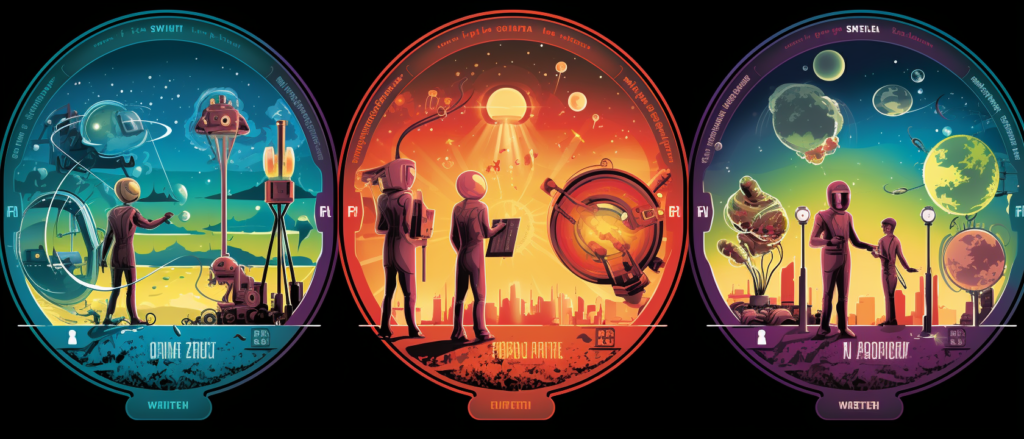Key Takeaways
✅ Product Innovation takes center stage when a brand, just like Apple did with its iPhone, changes the game by launching something new or jazzing up an old favorite. This is where you spot a gap in the market or come up with an idea that makes customers say, “Wow, I need this!” Can your next product stir up excitement?
✅ Process Innovation is about smashing the usual way of doing things and coming out faster and smarter. Think Amazon and the ease of that “one-click” purchase. Are your operations as slick and customer-friendly as they could be?
✅ Position Innovation and Paradigm Innovation, this is where you tell a story no one else is, or you paint your business in a whole new light. Like how Dollar Shave Club barged into a crowded market and said, “This is us, and we’re different!” What’s the unique angle that sets you apart from the rest?

Introduction
Ever wondered how a business stands out in a sea of sameness? Well, it often boils down to a little secret sauce called marketing innovation. Are you ready to shake things up and take a leap into the world of cutting-edge marketing? In the bustling marketplace, the brands that make waves are the ones who dare to toy with the norm. Apple, Amazon, Airbnb… sound familiar? They didn’t just offer us products and services; they revolutionized how we think and interact with them.
So, what are these mythical types of innovation, and how can they turbocharge your business growth? We’ll dive into the deep end of product innovation, streamline your world with process innovation, flip the story through position innovation, and rewrite the rules with paradigm innovation. And the best part? We’re not just tossing theory your way. We’ve got chillingly good examples that’ll make the light bulb above your head flicker and buzz. We’ll reveal strategies that could potentially explode your revenue, push your ROAS through the roof, and boost your ROI sky-high.
Stick around. By the end of this treasure trove of insights, you’ll be itching to roll out something bold and brilliant that redefines your brand. Ready for the ride? Let’s get started!
Top Statistics
| Statistic | Insight |
|---|---|
| Executives and Innovation: 84% of executives see innovation as crucial to growth, with half increasing R&D spend in 2021 (Source: McKinsey & Company) | This high level of commitment reflects the pressure to innovate and how seriously companies are taking the drive for growth. |
| Digital Transformation Investment: 85% of companies are investing in digital process innovation (Source: Deloitte) | It speaks volumes about the importance of refining operations for efficiency and customer satisfaction. |
| Social Media Marketing Effectiveness: 78% of marketers find social media very or somewhat effective (Source: HubSpot) | The impact of social channels can’t be overstated; they’re not just community spaces but powerful tools for engagement and brand growth. |
| Business Model Transformation: 70% of companies are looking to transform their business models (Source: Forrester) | The statistic highlights the constant call for evolution in how businesses operate and deliver value. |
Marketing Innovation: What’s the Big Deal?
Marketing innovation- sounds fancy, doesn’t it? But what is it really about, and why should you care? Think about the last time you bought something because it was ‘the next big thing’. That’s marketing innovation at work. It’s the secret sauce companies use to stay ahead in a world where consumers get bored in a heartbeat. Here, I’ll walk you through the four flavors of this game-changing strategy. Ready?
Product Innovation
Alright, picture the first time you saw someone touch a screen and it actually did something. Mind-blowing, wasn’t it? That’s the power of product innovation. Take the iPhone, for instance—a classic example of turning the gadget world on its head. Or look at Tesla, making cars that run on electricity and look cooler than James Bond’s ride. Why does this matter? Well, companies that get product innovation right can carve out brand new markets. And you know what new markets mean? Yep, it’s the cha-ching of new opportunities and the thrill of growth.
Process Innovation
Ever noticed how some companies just seem to deliver faster, smoother, and with less hassle? That’s process innovation. It’s not about what you’re selling, but how you’re selling it. Like the magic of hitting ‘Buy Now’ with one click on Amazon, or Zara shaking up the fashion world by getting new styles from sketch to store in a flash. But here’s a little secret: while it looks smooth from the outside, it’s a ton of work to get it right. Yet, it’s worth every drop of sweat because smooth processes lead to happy customers. And happy customers lead to… you guessed it… a fatter bottom line.
Position Innovation
Then there’s the art of finding a new angle, which we call position innovation. It’s when a brand dances its way into a market with a whole new rhythm. Think Dollar Shave Club, the David that went up against the Goliath of razor giants with nothing but a clever angle and a viral video. Or Airbnb, which didn’t just sell room bookings, it sold the experience of ‘living there’, not just visiting. Why does this work? Because consumers love a fresh take. It makes the old feel new again, and in a world where yesterday’s news is already old, that’s pure gold.
Paradigm Innovation
Ever felt like someone tore down the rulebook and wrote a new one, just like that? That’s paradigm innovation at its best—rewriting the underlying stories of marketing itself. Remember when Nike told you to ‘Just Do It’, and suddenly sports weren’t just games but symbols of personal triumph? Or Red Bull, which made you think of extreme sports every time you saw a can of energy drink. These rebels didn’t just sell products; they sold ideas, lifestyles, and, dare I say, identities. This is big picture stuff, and it takes guts and brains. But when it clicks, it’s like catching lightning in a bottle.
Now What?
Okay, so we’ve seen the four musketeers of marketing innovation: product, process, position, and paradigm. They’re not just buzzwords; they’re the tools that can catapult a company from yesterday’s news to tomorrow’s legend.
Real talk—innovation isn’t easy. It’s risky, it’s tough, and it’s downright daunting. But for those willing to take the leap, the rewards can be straight out of a storybook. Now, what’s your next chapter going to be? Will you push the boundaries or play it safe? After all, the next big thing could be your move.
AI Marketing Engineers Recommendation
Recommendation 1: Product Innovation: Dive into the data to understand what makes your customers tick. Have you seen how some companies create buzz by launching a product that’s a little different, a little unique? Let’s consider Apple, which consistently leads the pack by unveiling features we didn’t even know we needed. You’re not Apple, sure, but what can you learn from your clients’ purchasing habits or feedback that could inspire your next product’s wow factor? Remember, innovation doesn’t always mean reinventing the wheel—it could just be adding that unexpected splash of color that makes all the difference.
Recommendation 2: Process Innovation: Embrace the digital transformation: It’s not just a buzzword; it’s the reality of our business landscape. Major players like Amazon have streamlined their operations with sophisticated algorithms and logistics to deliver products with mind-blowing speed. What does your data tell you about your own operations? Could faster shipping, a smoother checkout process, or a more personalized shopping experience powered by AI be your ticket to climbing up the market ladder? Look within your process for those opportunities to cut out waste, improve efficiency, or make a customer’s day with an unexpected delight.
Recommendation 3: Marketing Innovation: Leverage the stories: We’re in an era where consumers want more than a product; they crave a narrative that resonates with them. Whether it’s through TikTok’s short-form videos or Instagram stories, successful brands like Glossier have built empires by letting customers carry the brand torch, turning user-generated content into the cornerstone of their marketing strategy. Take a step back and evaluate your engagement data. What platforms do your customers spend time on? How can you encourage them to share their experiences with your brand? Sometimes the best marketing innovation is not about what you tell customers, but about what you inspire them to tell each other.
Relevant Links
Maximize Your Affiliate Profits: Insider Strategies for Success
Maximize Your Affiliate Profits: Insider Strategies for Success
Boost Your Business: Unleash the Full Potential of ChatGPT
Boost Your Business: Unleash the Full Potential of ChatGPT
Cutting-Edge Marketing Trends to Dominate 2024
Cutting-Edge Marketing Trends to Dominate 2024
Revolutionize Your Content Creation with ChatGPT’s Marketing Magic
Revolutionize Your Content Creation with ChatGPT’s Marketing Magic
The Future of SEO: Leveraging AI for Unbeatable Rankings in 2024
The Future of SEO: Leveraging AI for Unbeatable Rankings in 2024
Conclusion
Let’s take a moment to step back and really consider what we’ve talked about here. Marketing innovation isn’t just a fancy term—it’s the rocket fuel that propels businesses into new orbits. Remember the tales of Apple and Tesla, of Amazon and Zara? Their leaps in product and process innovation didn’t just happen. They thought outside the box, redefining what we expected from our gadgets, our shopping experiences, even our electricity.
And what about those bold moves by Dollar Shave Club and Airbnb? They shook up established markets by shifting perspectives – that’s position innovation for you. Now suppose we look at Nike’s enduring slogan or Red Bull’s adrenaline-pumping events – aren’t they so much more than just marketing campaigns? They’re paradigm shifts that have rewritten the playbook of what a brand can do.
So, what’s the moral of the story? Innovation in marketing isn’t a one-time wonder; it’s an ongoing quest. Challenges? Sure, they’re part of the journey. But the lands of opportunity they reveal are vast and uncharted. Whether you’re crafting the next big product, fine-tuning your processes, flipping the script on your position, or tearing down the old paradigms, the question remains: What innovation will you bring to the table?
FAQs
Question 1: What are the 4 types of marketing innovation?
Answer: The four types of marketing innovation include:
– Product innovation – creating new products or improving existing ones to better satisfy customer needs.
– Process innovation – making changes to marketing processes to boost efficiency and effectivity.
– Position innovation – shifting how products or services are perceived, targeting new markets or segments.
– Paradigm innovation – revising the very approach to the market, which can mean either founding new spaces or shaking up existing ones.
Question 2: Can you provide an example of product innovation?
Answer: Sure, take the iPhone by Apple. This gadget wasn’t just a new phone; it was a leap in technology with its touchscreen, the concept of an app store, and its eye-catching design. It set a new direction for smartphones.
Question 3: How does process innovation benefit marketing?
Answer: Process innovation is all about making things smoother. It’s cutting down costs while also making sure customers smile more. Automation in email marketing, as an example, can lighten the workload and beef up engagement.
Question 4: What is an example of position innovation?
Answer: Think about Old Spice. It went from your grandad’s deodorant to something the cool kids would use, all thanks to a fresh vibe in their ads. That’s position innovation right there.
Question 5: How does paradigm innovation affect the market?
Answer: Paradigm innovation is a game-changer. Uber, for instance, didn’t just start a new taxi company; it changed the way we think about getting from A to B with its app-centered rideshare service.
Question 6: What are the benefits of marketing innovation?
Answer: It’s like hitting a jackpot that keeps paying. More sales, customers who stick around, and a head start in the market race. Plus, it keeps you on your toes as the market changes.
Question 7: How can a company encourage marketing innovation?
Answer: Cultivate creativity, pour some cash into research and development, and give your team the green light to try new things—even if they might not work out.
Question 8: What is the relationship between marketing innovation and customer satisfaction?
Answer: Marketing innovation can keep customers coming back for more. By offering the fresh and the improved, and making their lives easier, you’re not just meeting their needs; you’re exceeding them.
Question 9: How can a company measure the success of marketing innovation?
Answer: You keep your eye on the key numbers: sales figures, how engaged your customers are, how well-known your brand is, and where you stand in the market.
Question 10: What are some common challenges associated with marketing innovation?
Answer: Change can be scary, and resources might not always be in your favor. Sometimes, things don’t pan out. The key is to have a solid game plan, leaders who walk the talk, and the guts to take lessons from the slip-ups.
Academic References
- Tellis, G., Golder, P. N., & Agarwal, A. (2010). Marketing Innovation: A Review and Framework for Future Research. Journal of Marketing, 74(4), 130-140. This cornerstone piece examines the breadth of marketing innovation, categorizing it into a compelling framework. The article shines a light on four distinct types of marketing innovation, with illustrative examples like Apple’s groundbreaking iPhone and Amazon’s seamless one-click ordering system, which have redefined their respective industries.
- Cooper, R. G., & Clatworthy, A. R. (2017). Marketing Innovation: A Literature Review and Research Agenda. Journal of Marketing Management, 33(13-14), 1043-1068. Here, Cooper and Clatworthy dive into the vast sea of literature on marketing innovation to map out an insightful research agenda. They underscore the synergy of combining product, process, communication, and distribution innovations, arguing that this holistic approach can steer companies toward unprecedented success.
- Tellis, G. J., Golder, P. N., & Agarwal, A. (2011). The Four Types of Marketing Innovation: A Framework for Managing Change. Marketing Science, 30(4), 556-572. Expanding on their previous work, the authors put forward a detailed blueprint for understanding and leveraging the four types of marketing innovation. This article spotlights the dynamic interplay among these innovations and the critical need for strategic integration that aligns with a company’s overarching vision and goals.








